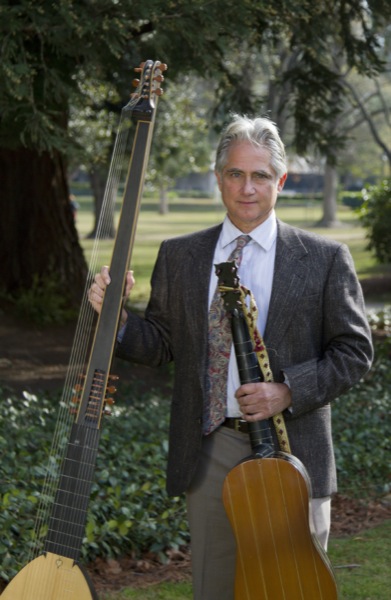Painting in sound: Savino, Ars Lyrica bring Goya masterpieces to life

Multimedia concerts are a hot trend, but they often go off on tangents that shed little or no light on the music. Give credit to Houston’s Ars Lyrica baroque ensemble for offering a combination that clicked.
“Goya’s World: Reflection and Revolution,” which the group performed Saturday in Zilkha Hall, dramatized the Spanish artist’s powerful works — projected onto a screen above the musicians — through music by his contemporaries.
That may seem far-fetched at first.
Even after 200 years, Goya’s painting and etchings can still be startling, especially in their mercilessly clear depictions of violence — be it the brutality of war or the bloodshed of bullfighting. Has anyone ever suggested that the music of Antonio Soler, Fernando Sor, Luigi Boccherini and others of their time can equal Goya’s wallop? Not likely.
But Ars Lyrica’s program, curated by guitarist Richard Savino, uncovered music that resonated with Goya’s creations — from the elegant world of his royal portraits to the fervor of his religious paintings and the lustiness of his amorous scenes. And a couple of soulful, turbulent works at least aimed in the same direction as Goya’s most visceral images.
Savino sat with his guitar at the center of a compact but vigorous ensemble that also included harpsichordist Matthew Dirst, mezzo-soprano Cecilia Duarte and five string players (Adam LaMotte and Maria Lin, violins; Erika Lawson, viola; Barrett Sills, cello; and Deborah Dunham, violone). Zilkha Hall’s flattering acoustics enhanced the group’s color and impact.
Soler’s dynamic Apertura opened the concert as a series of Goya self-portraits flashed onto the screen. Especially when Soler’s muscle-flexing flourishes accompanied a picture of the young Goya standing confidently before his easel, the music and image coalesced in a vivid depiction of an artist savoring his powers.
Part of the concert’s appeal lay in introducing compelling but unfamiliar music.
Por aquel horizonte, a Christmas-themed aria by Juan Iribarren, unfolded alongside religious paintings. The buoyant da capo aria could fit right into a score by Handel or Vivaldi, and Duarte’s warm, deft singing brought out its jubilation and sweetness in turn.
Another compelling discovery: Francisco Courcelle’s Lamentación 2 del Viernes Santo, a plaintive aria that bemoans human hardships and evildoing. It unfolded as Goya’s Caprichos depicted poverty and other sufferings, so Duarte and company’s spaciousness and lyricism became all the more potent.
Movements from Boccherini’s guitar quintets tied the program together. The airiness of the “Pastorale” from his Quintet No. 4 helped conjure up the world of Spain’s nobility. Not only did Savino and the group play it deftly, but when the screen zeroed in on the face of a woman shaded by a parasol, the muted violins’ airy tone caressed her cheek as softly as the light in the painting.
The “Fandango” from Boccherini’s Quintet No. 6 invited the players to dig in, and they did — especially cellist Sills, whose part included lusty glissandos and other sound effects.
Meanwhile, Goya’s bullfight images exploded from the screen. While the “Fandango” didn’t contain anything as potent as the sight of a bullfighter being gored or a bull being speared, the music nevertheless suggested the arena’s air of flamboyance and theatrics.
A handful of Sor’s tuneful, red-blooded songs fleshed out the desires and flirtations depicted in Goya’s amorous scenes. With Savino accompanying her fluently on the guitar, Duarte brought the songs’ ardor and spirit — spicing them up with a dash of gutsiness here, a bit of comic sassiness there.
Toward the concert’s close, more Sor songs illustrated Goya’s state of mind late in his life, when he was beset by deafness and poor health. Duarte’s simplicity captured the resignation of Cesa de atormentarme, a meditation on the pain of remembering past happiness.
Then the perspective widened again, and the concert climaxed with some of Goya’s most ferocious works — his depictions of the social unrest seizing Spain.
The turbulent Allegro Assai from Boccherini’s Quintet No. 1 became a septet, thanks to Dirst joining in on harpsichord and Dunham on violone. That and the group’s vigor lent the music fire and abandon, helping it underline the stark power of paintings like Goya’s Third of May, 1808 — the famous painting of a man flinging out his arms as a firing squad takes aim at him.
That image gave way to a portrait of the painter, then Boccherini’s music concluded as Goya’s Saturn Devouring His Son flashed onto the screen. Even more than the music, that grisly image ended the concert with a bang.
Ars Lyrica performs J.S. Bach’s Phoebus and Pan and Tönet ihr Pauken at 7:30 p.m. May 16 in the Hobby Center for Performing Arts. arslyricahouston.org/; 713-315-2525.